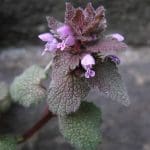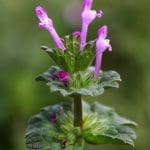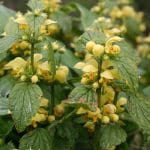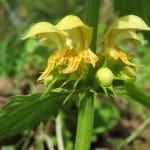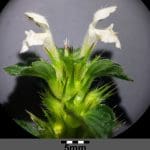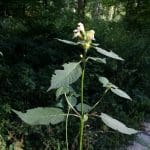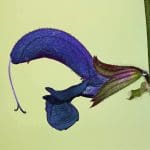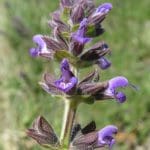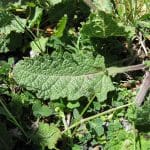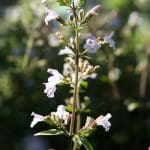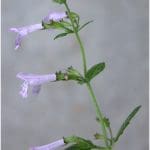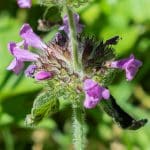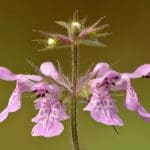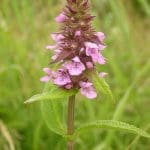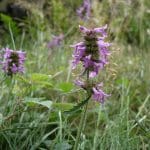In this post we’re going to look at one amazing trick to make you able to identify 50 wild edibles in just five minutes!
Mint must be one of the most recognisable and versatile flavours offered by the plant kingdom and is the common name used for the Labiate or Lamiaceae family. In this blog post we discover the wide variety of plants in this family and learn that there is more to mints than the traditional vinegar infused accompaniment to fatty meats, or the refreshing contrast of mint in choc-chip ice cream.
Worldwide there are about 7,500 species of mint. Don’t panic! There are only about 50 species growing wild or naturalised in Britain and only around 15 of these have the distinctive menthol aroma we associate with mint. These are the Mentha genus or wild mints . It is often difficult to identify wild mint species precisely as they frequently hybridise. Even in your garden, if you grow two different mint species close together they may cross-breed and acquire each other’s flavour.
Many reputable sources consider the mint family to be a safe plant family which has no really dangerous plants and no similar poisonous plants. However, there are some which should be avoided, namely the Hemp Nettles and Germanders, described below. Pennyroyal can also cause poisoning if consumed in large amounts or by ingestion of essential oil in which the toxin, pulegone, is present in much higher concentration than in the plant material.
Stem and Leaves
A characteristic feature of the Mint family is their square stem with leaves branching in opposite pairs along the stem; successive leaf pairs growing at 90 degrees to the previous pair. The leaves of a few species grow in whorls and some have lobed leaves, but the majority are in pairs and range in shape from triangular to oval, oblong or chordate, coming to a point at the tip, often with toothed edges.
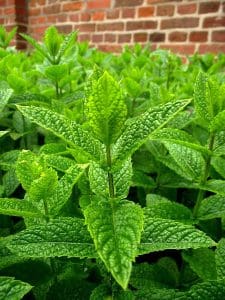
Other plants with square stems and opposite leaves which may initially be confused with mints are found in the Figwort, Loosestrife, Verbena and Stinging Nettle families. You may have to wait until they come into flower to be certain of the family and, particularly with the figwort family, look closely at the different parts of the flower.
Aroma
If they are not in flower another way to recognise mint is to crush and smell the leaf; if it is a mint, you will often be rewarded with the release of volatile, aromatic oils.
These essential oils are the reason so many of the mint family are popular culinary herbs. The family includes basil, rosemary, marjoram, oregano, peppermint, spearmint, germander, thyme, savoury, horehound and sage. The aromatic essential oils are at their peak just as they come into flower and enable mints to retain moisture and repel insects and herbivorous predators. This is particularly beneficial for those mints which prefer the hot, dry conditions of summer.
Recognising different mints
This may take some practice and familiarity with the species growing close to you. There are a few generalisations that provide a rough guide to some genera of the labiate family, which is a useful starting point.
Flowers
The distinctive flowers of the mint family are actually five petals fused into a tube, called a Corolla. The tube is surrounded by five green sepals, also fused together, called the Calyx.
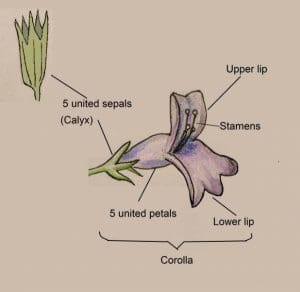
The size of the corolla, the pattern of the lobes at the mouth of the corolla and the way the flowers are arranged on the stem are important features to note. Features of the Calyx are also helpful to obtain an accurate identification and you may also need a magnifying glass to look at the smaller parts of the flower, such as the stamens .
Wild mints, Mentha spp on our way to identify 50 wild edibles
This genus has creeping stems above or below ground, small lilac-purple flowers in which the corolla is divided into four nearly equal lobes.
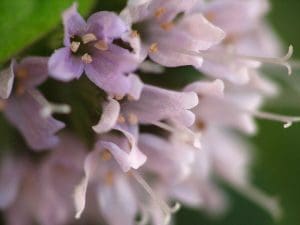
The distinctive menthol flavour compliments peas, lamb, chocolate and soft fruits or can be used as a syrup in soft drinks.
Water Mint, Mentha aquatica, is our most abundant wild mint and has a mild peppermint flavour.
Spearmint, Mentha spicata, is the sweet flavoured mint used most frequently in cooking. It is used in mint sauce and as a flavouring for toothpaste and chewing gum.
Peppermint, Mentha piperita, is a hybrid of Water Mint and Spearmint and is the mint most commonly used in mint tea. It is used more in confectionary than in savoury dishes.
Pennyroyal, Mentha pulegium, should avoided by pregnant women and infants and generally be used sparingly and infrequently due to its pulegone content, which can damage the liver if consumed in large amounts. It is a protected species under Schedule 8 of the Wildlife and Countryside Act so it is an offence to gather it from the wild.
Round-leaved Mint, Mentha suaveolens, is not common nor intensely flavoured but it is pleasantly mild and sweet – suitable for desserts and salads.
Dead Nettles, Lamium spp
The corolla opens out into two lips. The lower lip has three lobes but the two side lips are very small and the middle lobe is divided into two large teeth.
The flowers form dense separated whorls in the leaf axils.
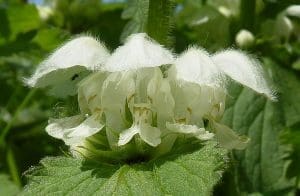
The leaves and young stems of Red Dead Nettle, Lamium purpureum, White Dead Nettle, L. album and Henbit, L. amplexicaule, are soft and succulent in salads or steamed as a vegetable accompaniment. The flowers make an attractive addition and sweetness to a dish.
Yellow Archangel, Lamiastrum galeobdolon can also be used the same way.
Hemp Nettles, Galeopsis spp: POISONOUS causing paralysis
The lower lip of the corolla has two narrow side lobes that are not much shorter than the middle lobe and two cone-shaped projections at its base.
Claries and Sages, Salvia spp
The upper corolla lip is strongly arched and they have only two stamens.
The basal leaves of Wild Clary form a rosette and could be confused with those of Ragwort or Groundsel, but the leaves of Ragwort and Groundsel are lobed rather than toothed and have an unpleasant smell.
Meadow Clary, Slavia pratensis, and Wild Clary, S. verbenaca, are closely related to cultivated sage, S. officinalis. The leaves taste faintly of sage and can be deep fried in tempura batter or finely chopped and sprinkled on soups. The flowers have a distinct sage flavour and can be used in salads or as a garnish. The seeds can be added to soups and stews as a thickener or toasted and sprinkled on salads.
Calamints and Wild Basil, Clinopodium spp
Whorls of delicate flowers with quite long tubular corollas at the top third of each stem, varying in colour from purple to violet to pale pink.
Lesser Calamint is more aromatic than Common Calamint and has a more delicate minty flavour than Water mint, Spearmint or Peppermint. To make an infusion use warm liquids rather than boiling to avoid losing the aromatic oils.
Wild Basil also has a mild flavour that is somewhere between mint and marjoram. Quite large quantities are required to notice its flavour in salads.
Woundworts, Stachys spp (includes Betony, Betonica officinalis)
Similar to dead nettles but they have a long spike-like inflorescence. The corolla has a concave but not helmet-shaped upper lip. The middle lobe of the lower lip is oblong, much larger than the two side lobes and is convex with a pattern of streaks and dots.
The tubers can be eaten raw or cooked and have a crisp texture and a sweet, nutty flavour like chestnuts.
As its name suggests, Woundwort has been used as a wound-healing herb. Also known as Allheal, it is reported to stop bleeding and has antiseptic properties.
Self Heals, Prunella spp
Flowers form dense oblong heads. The calyx has a purple hue and isi flattened above and below.
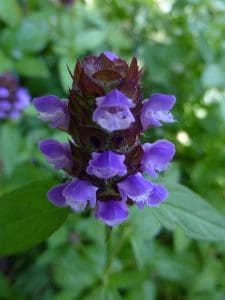
Leaves work well in salad and provide a good background to other flavours.
Bugles, Ajuga spp
The lower lip is three lobed and the upper lip is reduced to two unobvious small teeth.
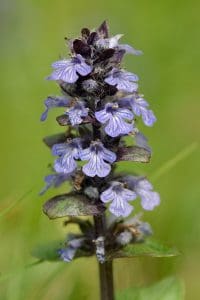
Bugle has many uses, both as a medicinal and edible herb. The leaves can be used as a potherb in salads. Uncooked they taste bitter, but are more palatable when cooked. The roots and tubers can be boiled or cooked.
This perennial herb has a long history of medicinal uses as anti-inflammatories, antioxidants and for treatment of respiratory disorders. It has also been used to treat stress and anxiety, haemorrhaging, hangovers and bruising.
Germanders, Teucrium spp: TOXIC
The corollas have no upper lip but a five-lobed lower lip – the central lobe is much larger than the others.
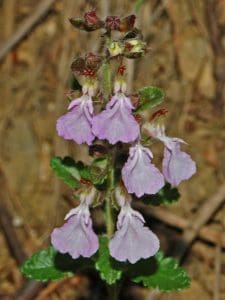
It is unsafe to consume germander, and its sale has actually been banned in France. Research has concluded that germander may cause liver disease and even death in some cases.
This is far from an exhaustive list and it doesn’t include many useful culinary species of the mint family that don’t fall into the genera above. For example:
Ground Ivy, Glechoma Hederacea
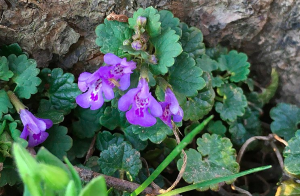
The kidney-shaped, cordate leaves can be used in place of mint or thyme. It has a distinctive flavour, which was used to flavour beer before hops came into use; hence its older name of Alehoof.
Bastard Balm, Melittis melissophyllum
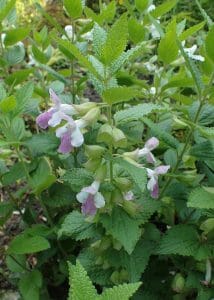
The whole plant contains coumarin, the vanilla-almond flavouring also found in melilot, sweet woodruff and sweet vernal grass. This is used to flavour sweet and savoury dishes. The leaves can be used whole in salads and have a soft texture.
White Horehound, Marrubium vulgare
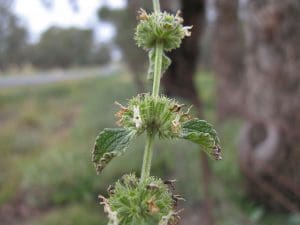
A cough sweet flavoured with White Horehound used to be manufactured on a large scale.
White Horehound Lozenges
Ingredients:
- 1/4 cup dried or 1 cup fresh leaves and stems
- 3 cups of warm water
- 3 cups sugar
- 1 teaspoon cream of tartar
- 1 teaspoon fresh lemon juice
- 1 teaspoon butter
Infuse the leaves in warm water for 30 minutes then strain through a fine sieve. Add sugar, cream of tartar and lemon juice to the water and boil until it reaches 115 C. Add the butter and continue heating until it reaches 135 C.
Pour into a flat greased tin or candy mould with squares and leave to cool and harden. When hard remove from candy mould or cut into squares. Shake in a tin with some icing sugar and store between greaseproof paper in a dry, airtight container.
Wild Marjoram, Origanum vulgare
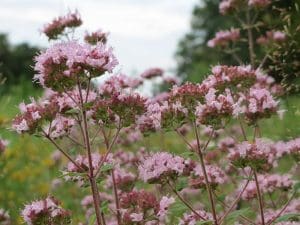
A strong flavour which works in tomato-based dishes and salads.
Thymes, Thymus
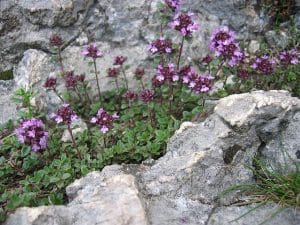
Use as you would cultivated Thyme, it goes particularly well with chicken and in Italian food. It’s also great for flavouring oils and vinegars.
References for our guide to identify 50 wild edibles:
Rose, F, 1981, The Wild Flower Key, British Isles – N.W. Europe, Penguin Books Ltd.
Elpel, TJ, 2018, Botany in a Day, HOPS Press.



